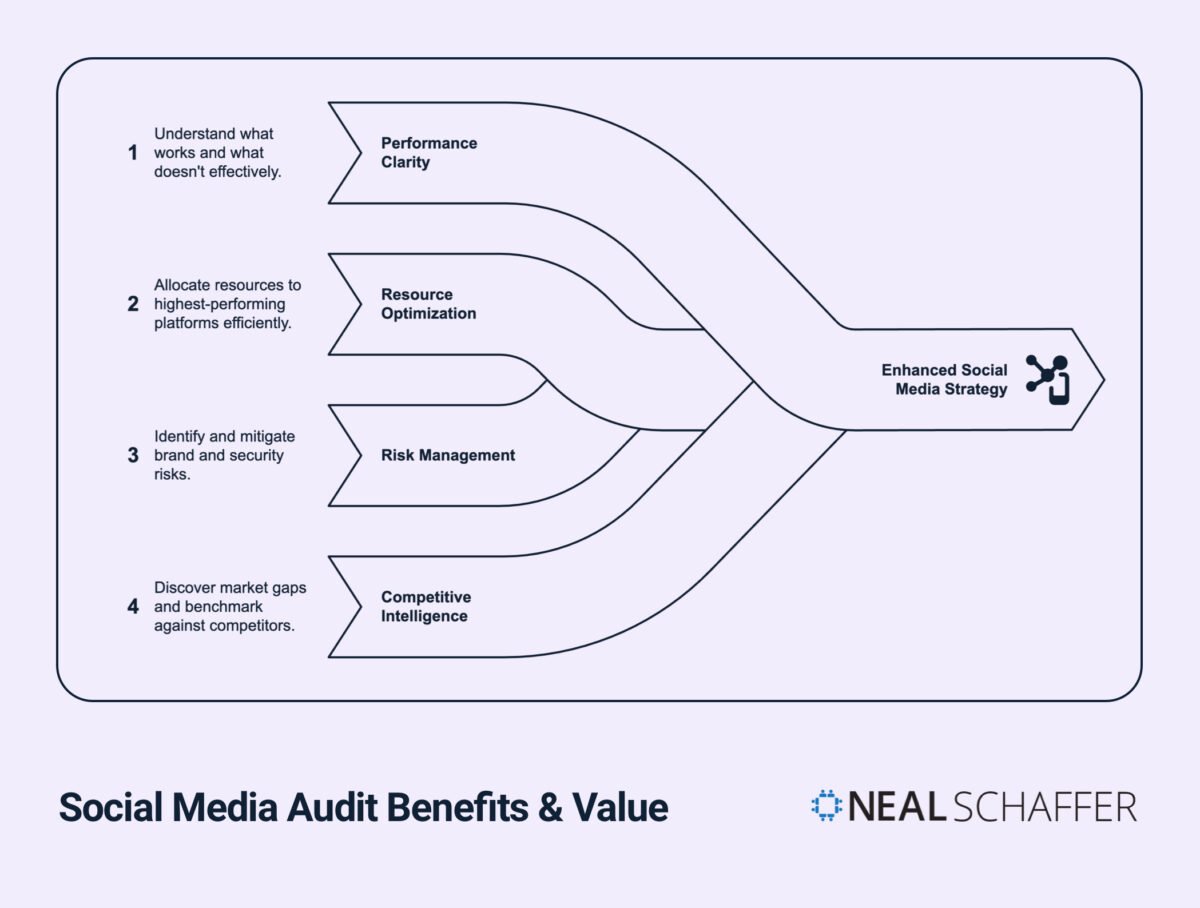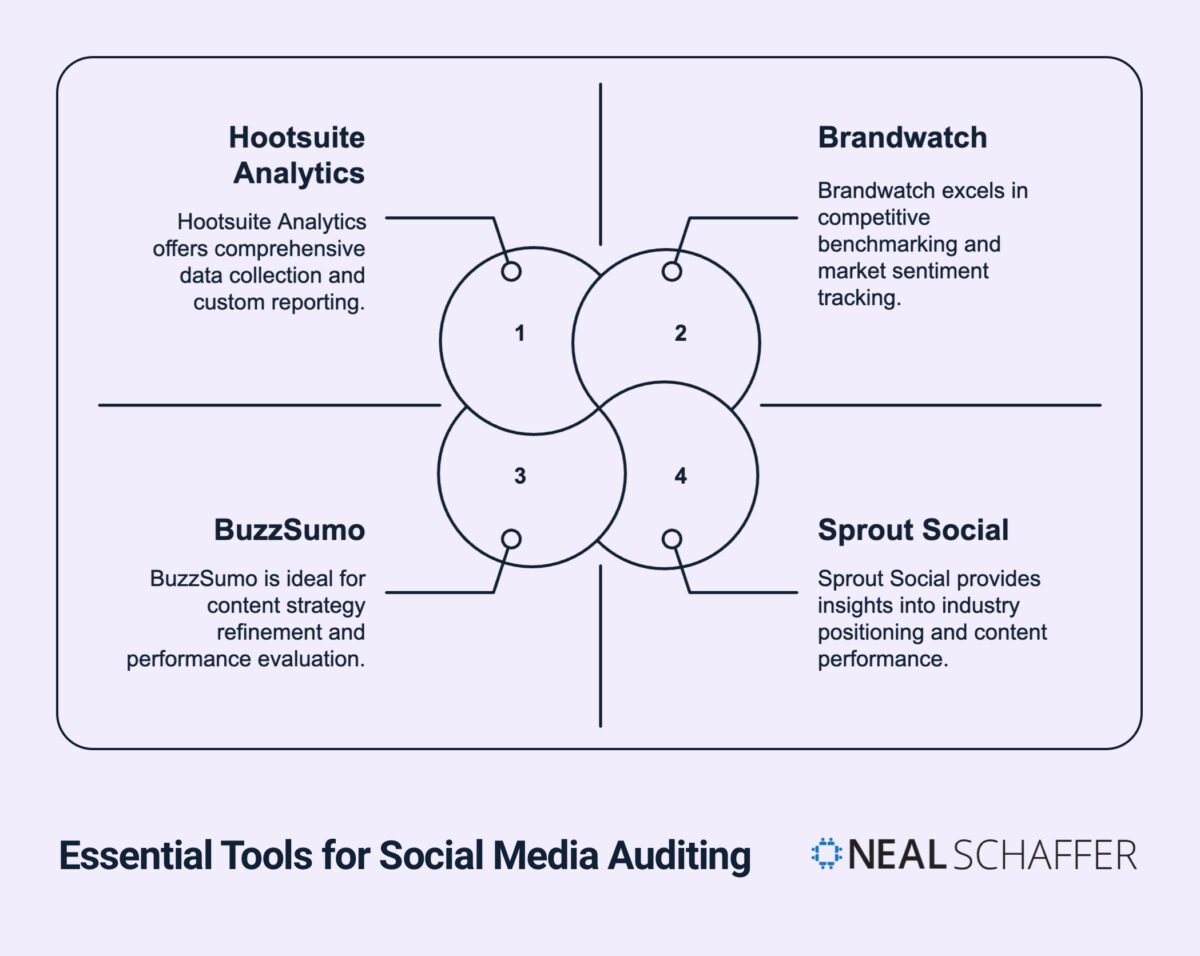Social media audits are critical for marketing success. They provide a structured approach to evaluate your social presence, identify problems, and uncover growth opportunities. Yet many businesses neglect this vital process, continuing with strategies that may no longer serve them well. A thorough audit is the difference between data-driven decisions and guesswork.
This checklist will guide you through conducting a professional social media audit. You’ll learn how to assess your current performance, analyze competitors, and develop a strategic action plan based on real insights. By implementing regular audits, you’ll optimize your social media efforts and deliver measurable business results.
As an entrepreneur since launching my marketing consulting business in 2010, I’ve seen how regular social media audits transform marketing effectiveness for my clients. I believe this systematic evaluation is the foundation of any successful social media strategy.
What is a Social Media Audit and Why Does it Matter?
A social media audit is a systematic examination of your organization’s social media presence and performance across all platforms. It involves collecting, analyzing, and interpreting data to evaluate effectiveness and identify improvement opportunities.
Businesses that conduct regular social media audits gain significant advantages. They can quickly identify underperforming channels, reallocate resources to high-performing areas, and stay ahead of competitors. Without regular audits, you’re essentially operating on assumptions rather than evidence.
The audit process also provides crucial documentation of your social media assets. Many organizations are surprised to discover dormant accounts or inconsistent branding during their first comprehensive audit. This record-keeping aspect alone can save significant headaches during personnel transitions or when expanding to new markets.
Key Benefits of Regular Social Media Audits

Regular social media audits deliver multiple benefits that directly impact your marketing success:
- Performance clarity: Gain objective insights into what’s working and what isn’t
- Resource optimization: Allocate your budget and team efforts to the highest-performing platforms
- Strategic alignment: Ensure social activities support broader business objectives
- Competitive intelligence: Identify gaps and opportunities in your market position
- Risk management: Discover and address potential brand inconsistencies or security issues
Beyond these immediate benefits, audits create accountability and foster a culture of continuous improvement within your marketing team. When everyone knows performance will be regularly evaluated, quality standards naturally rise.
Preparation Steps for Your Social Media Audit
Before diving into the actual audit, proper preparation ensures you’ll capture accurate, comprehensive data. This groundwork phase is crucial for an efficient process and meaningful results.
Start by defining clear objectives for your audit. Are you primarily concerned with content performance? Channel growth? Competitive positioning? Your goals will determine which metrics receive the most attention and how you’ll structure your findings.
Next, gather access credentials for all official accounts. This may require coordination across departments, as social media management often spreads throughout organizations. Create a secure document to store this information for future audits.
Determine your audit timeframe. For the most useful insights, analyze at least 3-6 months of data. If you’re conducting your first audit, you might extend this period to establish baseline performance. I recommend that every business should conduct audits on a quarterly basis for optimal monitoring.
Finally, prepare your audit documentation templates. Standardized formats allow for easier comparison between platforms and across time periods. They also streamline the process for future audits.
Essential Tools for an Effective Social Media Audit

The right tools dramatically improve audit efficiency and data accuracy. Below is a comparison of essential tools for different aspects of your social media audit:
| Tool Category | Recommended Options | Primary Function | Best For |
|---|---|---|---|
| Analytics Platforms | Hootsuite Analytics, Sprout Social, Buffer Analyze | Cross-platform performance tracking | Comprehensive data collection |
| Reporting Tools | Google Data Studio, Databox, Supermetrics | Data visualization and reporting | Executive presentations |
| Competitor Analysis | Brandwatch, Brand24, Sprout Social | Competitive benchmarking | Industry positioning |
| Content Analysis | BuzzSumo, Sprout Social, Iconosquare | Content performance evaluation | Content strategy refinement |
Hootsuite stands out for enabling custom reporting across platforms, making it particularly valuable for comprehensive audits.
These tools help streamline the data collection process, allowing you to focus on analysis and strategic planning rather than manual data gathering. Selecting the right combination of tools for your specific needs will make the audit process more efficient and insightful.
The Comprehensive Social Media Audit Checklist
This checklist breaks down the social media audit process into manageable steps. Following this structured approach ensures you’ll capture all essential elements while keeping the process organized and repeatable.
Step 1: Profile Inventory Assessment
Begin with a complete inventory of all your social media accounts. This foundational step often reveals surprising findings, from forgotten accounts to unauthorized profiles.
According to Harvard Business Review’s audit template, you should list all active and inactive accounts including follower counts for a comprehensive view of your social presence.
Here’s a structured approach to profile inventory:
Is Your LinkedIn Not Delivering Results?
Just released: my new book to help professionals, entrepreneurs, and business owners maximize LinkedIn for real growth.
With years of LinkedIn expertise, Maximizing LinkedIn for Business Growth offers actionable steps to build your brand, expand your network, and drive results.
Start leveraging LinkedIn like never before—grab your copy now! Click the cover or button below to buy on Amazon.
| Platform | Account URL | Status | Follower Count | Monthly Growth Rate | Primary Manager | Action Required |
|---|---|---|---|---|---|---|
| facebook.com/yourbrand | Active | 25,845 | 2.3% | Marketing Team | None | |
| twitter.com/yourbrand | Active | 18,732 | 1.8% | Social Media Manager | Verify account | |
| linkedin.com/company/yourbrand | Active | 12,458 | 3.2% | HR Department | Update banner image | |
| instagram.com/yourbrand | Active | 34,921 | 4.1% | Marketing Team | None | |
| YouTube | youtube.com/c/yourbrand | Inactive | 5,243 | 0.2% | Unassigned | Develop content plan |
For each account, document the URL, current status (active, inactive, abandoned), follower count and growth rate, verification status, and the person or team responsible for management. Note any immediate action items like profile updates or recovery of forgotten login credentials.
This inventory becomes particularly valuable during team transitions or when developing a new social media strategy. Having all accounts documented in one place provides clarity and prevents valuable brand assets from being forgotten.
Step 2: Brand Consistency Evaluation
Once you’ve cataloged all accounts, evaluate brand consistency across platforms. According to Sprinklr’s 9-step audit guide, you should verify that branding aligns across all profiles, including bios and contact information.
Use this table to score your brand consistency across platforms:
| Brand Element | YouTube | Action Items | ||||
|---|---|---|---|---|---|---|
| Profile Image | ✓ | ✓ | ✓ | ✓ | ✓ | None |
| Cover/Banner Image | ✓ | N/A | ✓ | ✗ | ✓ | Update LinkedIn banner |
| Bio/Description | ✓ | ✗ | ✓ | ✓ | ✗ | Update Instagram and YouTube bios |
| Contact Information | ✓ | ✓ | ✗ | ✓ | ✗ | Add contact info to Twitter and YouTube |
| Brand Voice | ✓ | ✓ | ✓ | ✗ | ✓ | Align LinkedIn content with brand voice |
Pay particular attention to visual elements like profile pictures and cover images. These visual cues should instantly identify your brand regardless of platform. Similarly, your brand’s voice and messaging should maintain consistency while still adapting to each platform’s unique culture.
Inconsistencies often develop when multiple team members manage different accounts or when profiles are set up at different times. Your audit gives you the opportunity to standardize these elements and strengthen your brand identity across all touchpoints.
Step 3: Performance Metrics Analysis
Performance metrics provide objective evidence of your social media effectiveness. According to Sprout Social’s cross-channel analytics recommendations, you should track engagement rate, reach, and referral traffic as your core metrics.
When analyzing performance, compare both against your own historical data and industry benchmarks. This comparative approach reveals whether performance changes reflect your specific efforts or broader industry trends.
Here’s a framework for evaluating key performance metrics by platform (data is fictional):
| Platform | Engagement Rate | Reach/Impressions | Referral Traffic | Conversion Rate | Growth vs. Last Period |
|---|---|---|---|---|---|
| 2.1% | 45,000 | 980 | 3.2% | +0.3% | |
| 4.7% | 78,500 | 320 | 2.8% | +1.2% | |
| 1.8% | 34,200 | 410 | 1.5% | -0.4% | |
| 3.4% | 15,700 | 1,240 | 5.1% | +2.3% | |
| YouTube | 6.2% | 8,900 | 190 | 1.9% | +0.7% |
For each platform, analyze these key metrics:
- Engagement rate: The percentage of your audience that interacts with your content
- Reach/impressions: How many users see your content
- Referral traffic: Visitors directed to your website from social platforms
- Conversion rate: The percentage of visitors who complete a desired action
- Growth trends: Performance changes compared to previous periods
Don’t limit your analysis to aggregated metrics. Drill down into individual post performance to identify content types and topics that resonate most with your audience. This granular analysis provides actionable insights for content planning.
Step 4: Audience Demographics Review
Understanding who follows and engages with your brand across platforms is crucial for targeted content creation. Each platform offers built-in analytics that provide demographic insights about your audience.
During your audit, document these demographic profiles by platform and compare them to your target audience personas. This analysis often reveals platforms where you’re successfully reaching your target audience versus those where your followers don’t match your ideal customer profile.
Pay special attention to:
- Age and gender distribution
- Geographic location
- Language preferences
- Professional information (especially on LinkedIn)
- Interests and behaviors (when available)
Beyond demographics, analyze when your audience is most active on each platform. These timing insights help optimize your posting schedule for maximum visibility and engagement. Most analytics tools offer hour-by-hour and day-by-day activity reports that can guide your content calendar.
The importance of consumer trust can’t be overstated in this analysis. 25% of brand-related web searches include user-generated content, highlighting how audience engagement directly impacts brand perception.
Step 5: Content Performance Evaluation
A thorough content performance analysis reveals which content types, topics, and formats drive the most engagement and conversions. This step provides direct input for your content strategy refinement.
Start by identifying your top-performing content across each platform. Look for patterns in:
- Content format (images, videos, text, links)
- Content topics or themes
- Post length or duration
- Use of hashtags or mentions
- Posting time and day
- Call-to-action style
Similarly, analyze your lowest-performing content to identify what to avoid in future posting. The contrast between your best and worst performers often reveals clear patterns that should guide your content strategy.
Track posting frequency and consistency as well. Irregular posting schedules can negatively impact algorithm visibility and audience retention. Your audit should evaluate whether you’re maintaining optimal posting cadence for each platform.
For social media content creation, this analysis provides invaluable guidance on what resonates with your audience. Use these insights to develop content themes and formats that consistently perform well.
Step 6: Competitor Analysis
Competitive analysis provides context for your own performance and reveals opportunities you might otherwise miss. You should use social listening tools to monitor competitors’ strategies and identify gaps in the market.
Identify 3-5 direct competitors and 2-3 aspirational brands for analysis. For each competitor, examine:
- Follower count and growth rate
- Posting frequency and consistency
- Content mix and themes
- Engagement metrics
- Unique features or approaches
- Share of voice in your industry
Look for content gaps where competitors aren’t serving audience needs. These represent opportunities for your brand to provide unique value. Similarly, identify successful approaches that you might adapt for your own strategy.
The social media analytics from this competitive review provide crucial benchmarks for evaluating your own performance in context rather than in isolation.
Step 7: Channel-Specific Opportunities
Each social platform offers unique features and opportunities that may not be fully utilized in your current strategy. This step identifies platform-specific tactics to improve performance.
For instance, 41% of marketers said the majority of the brands they work with rely solely on Instagram’s shopping tools. On the other hand, we know that 44% of TikTok users in the United States have made a purchase from TikTok Shop.
For each platform, assess:
- Underutilized features (Stories, Reels, Polls, etc.)
- Platform-specific content opportunities
- Advertising options and targeting capabilities
- Community building features
- Ipossibilities with your other marketing channels
Create an inventory of platform-specific opportunities prioritized by potential impact and implementation difficulty. This becomes your platform enhancement roadmap following the audit.
When evaluating these opportunities, consider both organic and paid approaches. Many platforms now limit organic reach, making strategic paid promotion an essential component of effective social media management.
Turning Audit Insights into Strategic Action
A social media audit is valuable only if it leads to strategic action. This section outlines how to transform your findings into an actionable plan for social media optimization.
Start by categorizing your findings into:
- Critical issues requiring immediate attention
- High-impact opportunities for near-term implementation
- Strategic shifts requiring longer-term planning
- Maintenance items for ongoing monitoring
This prioritization ensures you address the most important items first while creating a roadmap for continuous improvement.
For immediate issues, create a simple action plan with specific tasks, owners, and deadlines. These might include fixing broken links, updating outdated information, or addressing significant brand inconsistencies.
For strategic opportunities, develop more comprehensive plans that align with your broader marketing goals. These might involve new content series, channel expansion, or resource reallocation based on performance data.
Document your current baseline metrics from the audit, then establish specific targets for improvement. These become your key performance indicators for measuring the effectiveness of your post-audit action plan.
Importantly, don’t try to implement everything at once. Focus on the changes that will deliver the greatest impact for your specific business objectives. Using the social media insights from your audit, you can make data-backed decisions about where to invest your time and resources.
Setting Measurable Goals Based on Audit Findings
The audit provides a data-based foundation for setting realistic improvement goals. These goals should follow the SMART framework: Specific, Measurable, Achievable, Relevant, and Time-bound.
Based on your audit findings, establish goals in these key areas:
- Audience growth targets by platform
- Engagement rate improvements
- Content performance metrics
- Conversion and traffic goals
- Brand consistency measures
For each goal, establish clear KPIs that directly tie to your business objectives. While vanity metrics like follower counts are easy to track, focus primarily on metrics that impact your bottom line such as conversion rates and qualified lead generation.
Create a structured monitoring system to track progress toward these goals. Regular check-ins between full audits help maintain momentum and allow for timely tactical adjustments.
Social Media Audit Best Practices
To maximize the value of your social media audits, follow these established best practices from industry experts:
Audit Frequency and Timing
Establish a regular audit schedule that balances thoroughness with practical resource constraints. According to Sendible’s research, quarterly audits work well for most businesses, allowing for timely strategy adjustments without excessive administrative burden.
Consider conducting mini-audits monthly to track progress on key metrics while reserving more comprehensive reviews for quarterly, bi-annual, or annual schedules. Many organizations align their full audit timeline with their fiscal planning cycle to inform budgeting decisions.
The ideal timing often depends on your industry’s seasonal patterns. Retail businesses might audit before major shopping seasons, while B2B companies might align with fiscal quarters. Whatever schedule you choose, consistency is key for meaningful trend analysis.
Using social media management tools with automated reporting features can significantly reduce the time investment required for regular audits.
Common Social Media Audit Mistakes to Avoid
Even well-intentioned audits can fall short when these common pitfalls aren’t avoided:
1. Surface-level analysis: Collecting data without extracting meaningful insights
2. Focusing solely on quantitative metrics: Missing the qualitative aspects of brand perception and content quality
3. Auditing in isolation: Not involving stakeholders from other departments who contribute to or benefit from social media
4. Analysis paralysis: Gathering excessive data but failing to take action
5. Not documenting methodology: Making it difficult to conduct consistent comparisons over time
Perhaps the most significant mistake is treating the audit as a one-time event rather than part of a continuous improvement cycle. Each audit should build on previous findings, tracking progress on identified issues while exploring new opportunities.
Another mistake is not creating a standardized social media strategy template for your audits. Consistent documentation allows for meaningful comparisons across time periods.

Conclusion
A thorough social media audit provides the foundation for strategic optimization of your digital presence. By systematically evaluating your profiles, content, audience, and performance, you gain actionable insights that drive measurable improvements.
The audit process reveals both quick wins and strategic opportunities. Immediate fixes like brand consistency updates can deliver rapid benefits, while deeper findings inform long-term strategy development and resource allocation decisions.
Providing you business value is my passion. I believe regular audits are one of the most valuable yet underutilized practices in social media marketing. They transform vague impressions into concrete data, revealing exactly where your efforts are paying off and where adjustments are needed.
With the comprehensive checklist and templates provided in this guide, you now have everything needed to conduct a professional-grade social media audit. Take the first step today by scheduling your initial audit and discovering the opportunities hiding in your social media data.










